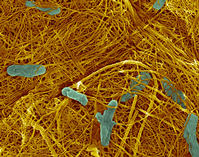
-[en] Scanning electron microscopy image of Shewanella oneidensis -
- source: EMSL -
Te mikroelektrarne pospešeno burijo duhove alternativnih virov energije, še posebno odkar so se gorivne celice prve generacije izkazale za energetsko in tehnološko šibke. Na Univerzi v Minesoti so odkrili, da je v ključni mehanizem pretvorbe hranil iz okolja v električno energijo vključen vitamin B2 (riboflavin) in tako naredili prvi korak na doslej nepoznano pot pretvorbe.
V poskusu so dokazali, da bakterije rastoče na elektrodah proizvajajo riboflavin, ki je deloval kot prenašalec elektronov od bakterijskih celic do elektrod. S kopičenjem riboflavina so povečali novo električne proizvodnje na 370 odstotkov. Ob ustrezno povečani kapaciteti gorivne celice takšna zmogljivost proizvodnje električne energije menda že zadošča za čiščenje odpadnih voda ali napajanje aktivnih senzorjev v okolju. Za komercialno aplikacijo bo zmogljivost potrebno še nadalje izboljšati.
[en] These micro electricity plants became even more interesting to the alternative energy sector, when the future of the first wave of fuel-cells was shattered due to efficiency and technology 'issues'. Not long ago, the energy transformation pathway of Shewanella was a mystery. Last year, the researchers of the University of Minnesota discovered, that vitamin B2 (riboflavin) is the key factor in the bacterial electricity production.
Bacteria growing on electrodes were producing riboflavin, as it played the role of electron transporter from the bacterial cell to the electrode. The experiment showed that as riboflavin concentrations increased, so did the the rates of electricity production (up to 370 percent). With such capacity and adequately up sized fuel-cell would be able to power waste water purification processes or active environmental sensors. Yet the commercial applications may be possible with further efficiency optimization.
- nanocevke Shewanelle / Shewanella nanotube filaments -
- source: UC Riverside -
Če takole malo na hitro zaškilimo med zgornjimi odstavki, zgleda kot da prihaja doba telefonov, računalnikov, mp*10n prevajalnikov, električnih fajf, plazma golf žogic in bohsigavedišečesa in njih izdelave iz skromnega 'prahu in blata', kajne?
[en] UC Riverside scientists have however, intended the Shewanella to another use. Whilst studying the bacteria bioremediation potential on the material contaminated material, the microorganisms formed arsenic-sulfide nanotubes, which had metal-like and photoconductive properties. Now, their goal is to employ the Shewanella to produce custom nano-photoconductive fibers, an environmentally friendly means of making essential components for future opto-electronic devices.
News like that makes you wanna think about a self organizing world of self building self powering electronic wonders, don' it?
druge povezave / other links:
- Electrifying Bacteria!
- The Shewanella Blogger
- Shewanella Federation
























1 komentar:
Živjo,
na spodnjem naslovu najdete še kakšno podrobnost na temo električnih bakterij,
Lijana
http://links.ealert.nature.com/ctt?kn=107&m=32270607&r=MTc2NzQwNDUxMQS2&b=2&j=NDc0MDM3MDES1&mt=1&rt=0
Objavite komentar